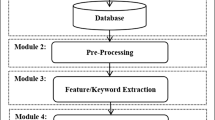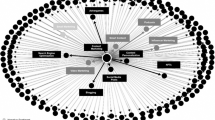Abstract
Customers making product purchases and businesses looking for feedback on their items have grown to rely on feature-based online comments provided by users on e-commerce platforms. As a result, it's critical to create aspect-based opinion mining frameworks that focus on obtaining consumers' feature-based judgments about products. Nowadays people convey their opinions and provide their experiences that significantly affect new purchasers in buying products, thus it leads to maintenance of large data sets. This massive amount of data is extremely beneficial for studying user preferences, desires, and behavior in relation to a product. E-commerce service providers face the difficult task of evaluating such vast amounts of data in order to derive client feedback. In order to resolve this issue, we explored Hypergraph with Helly property to perform emotion aware aspect-based opinion mining on real-world customer review data. In this paper, we are proposing a new distributed Hypergraph with Helly property algorithm for opinion mining to work on distributed Hadoop environment. Because of the large size data set, the suggested feature-based opinion mining system surpasses the alternative approaches in terms of greater accuracy and less time complexity, according to the performance evaluation using state-of-the-art methods. The proposed methodology is more efficient for extracting aspect-sentiment, categorizing, and summarizing online product reviews, according to the experimental results.













Similar content being viewed by others
References
Ali F, Kwak K-S, Kim Y-G (2016) Opinion mining based on fuzzy domain ontology and Support Vector Machine: A proposal to automate online review classification. Appl Soft Comput 47:235–250
Agarwal A, Xie B, Vovsha I, Rambow O, Passonneau RJ (2011) "Sentiment analysis of twitter data." Proceedings of the Workshop on Language in Social Media (LSM 2011), pp. 30–38
Archak N, Ghose A, Ipeirotis PG (2011) "Deriving the pricing power of product features by mining consumer reviews." Management science 57, no. 8:1485–1509
Asghar MZ, Ahmad S, Qasim M, Zahra SR, Kundi FM (2016) "SentiHealth: creating health-related sentiment lexicon using hybrid approach." SpringerPlus 5, no. 1:1139
Bai X (2011) Predicting consumer sentiments from online text. Decis Support Syst 50(4):732–742
Barbosa L, Feng J (2010) "Robust sentiment detection on twitter from biased and noisy data." In Proceedings of the 23rd international conference on computational linguistics: posters, pp. 36–44. Association for Computational Linguistics
Bouazizi, M, Tomoaki O (2017) "A pattern-based approach for multi-class sentiment analysis in Twitter." IEEE Access 5: 20617–20639
Bretto A (2013) "Applications of hypergraph theory: A brief overview." In Hypergraph Theory, pp. 111–116. Springer, Heidelberg
Cambria E, Schuller B, Xia Y, Havasi C (2013) "New avenues in opinion mining and sentiment analysis." IEEE Intelligent systems 28, no. 2:15–21
Chaturvedi I, Cambria E, Welsch RE, Herrera F (2018) Distinguishing between facts and opinions for sentiment analysis: Survey and challenges. Information Fusion 44:65–77
Deng Z-H, Luo K-H, Hong-Liang Yu (2014) A study of supervised term weighting scheme for sentiment analysis. Expert Syst Appl 41(7):3506–3513
Deshmukh JS, Amiya KT (2018) "Entropy based classifier for cross-domain opinion mining. Applied computing and informatics 1(14):55–64.
Ghani NA, Hamid S, Hashem IAT, Ahmed E (2019) "Social media big data analytics: A survey." Computers in Human Behavior 101: 417–428
Hou T, Yannou B, Leroy Y, Poirson E (2019) Mining customer product reviews for product development: A summarization process. Expert Syst Appl 132:141–150
Huang JX, Ben H, Jiashu Z (2018) "Mining authoritative and topical evidence from the blogosphere for improving opinion retrieval. 78:199–213
Hutto C, Gilbert,E (2014) "Vader: A parsimonious rule-based model for sentiment analysis of social media text." In Eighth international AAAI conference on weblogs and social media
Indurkhya N, Fred JD (2010) Handbook of natural language processing. Chapman and Hall/CRC
Jagdale RS, Shirsat, VS, Deshmukh SN (2019) "Sentiment analysis on product reviews using machine learning techniques." In Cognitive Informatics and Soft Computing, pp. 639–647. Springer, Singapore
Kim K (2018) An improved semi-supervised dimensionality reduction using feature weighting: Application to sentiment analysis. Expert Syst Appl 109:49–65
Kouloumpis E, Wilson T, Moore J.(2011).Twitter sentiment analysis: The "Twitter sentiment analysis: The good the bad and the omg!." In Fifth International AAAI conference on weblogs and social media.
Lu Y, Kong X, Quan X, Liu W, Xu Y (2010) "Exploring the sentiment strength of user reviews." In International Conference on Web-Age Information Management, pp. 471–482. Springer, Berlin, Heidelberg
Medhat W, Ahmed HH (2014) "Sentiment analysis algorithms and applications: A survey." Ain Shams engineering journal 5, no. 4 :1093–1113
Molnár B (2014) Applications of hypergraphs in informatics: a survey and opportunities for research. Ann Univ Sci Budapest Sect Comput 42:261–282
Mulder HM, Schrijver A (1979) "Median graphs and Hellyhypergraphs." Discrete Mathematics 25, no. 1: 41–50
Nielsen FÅ (2011) "A new ANEW: Evaluation of a word list for sentiment analysis in microblogs."
Pennebaker JW, Mehl MR, Niederhoffer KG (2003) Psychological aspects of natural language use: Our words, our selves. Annu Rev Psychol 54(1):547–577
Riaz S, Fatima M, Kamran M, Nisar MW (2019) Opinion mining on large scale data using sentiment analysis and k-means clustering. Clust Comput 22(3):7149–7164. https://doi.org/10.1007/s10586-017-1077-z
Saif H, He Y, Alani H (2012) Semantic sentiment analysis of twitter. In International semantic web conference. Springer, Berlin, Heidelberg. "Semantic sentiment analysis of twitter." In International semantic web conference, pp. 508–524. Springer, Berlin, Heidelberg
Saini M, Verma S, Sharan A (2019) "Multi-view Ensemble Learning Using Rough Set Based Feature Ranking for Opinion Spam Detection." In Advances in Computer Communication and Computational Sciences, pp. 3–12. Springer, Singapore.
Sivarajah U, Irani Z, Gupta S, Mahroof K (2020) "Role of big data and social media analytics for business to business sustainability: A participatory web context." Industrial Marketing Management, 86:163-179
Rathan M, Vishwanath R, Hulipalled KRV, Patnaik LM (2018) "Consumer insight mining: Aspect based twitter opinion mining of mobile phone reviews." Applied Soft Computing 68:765–773
Tewari AS, Jain R, Singh JP, Barman AG (2019) "Personalized Product Recommendation Using Aspect-Based Opinion Mining of Reviews." In Proceedings of International Ethical Hacking Conference 2018, pp. 443–453. Springer, Singapore
Wang, H, Dogan C, Abe K, François B, Shrikanth N (2012) "A system for real-time twitter sentiment analysis of 2012 us presidential election cycle." In Proceedings of the ACL 2012 system demonstrations, pp. 115–120. Association for Computational Linguistics
Wang WM, Li Z, Tian ZG, Wang JW, Cheng MN (2018) Extracting and summarizing affective features and responses from online product descriptions and reviews: A Kansei text mining approach. Eng Appl Artif Intell 73:149–162
Wilson T, Wiebe J, Hoffmann P (2005) "Recognizing contextual polarity in phrase-level sentiment analysis." In Proceedings of Human Language Technology Conference and Conference on Empirical Methods in Natural Language Processing
Wu C, Fangzhao Wu, Sixing Wu, Yuan Z, Huang Y (2018) A hybrid unsupervised method for aspect term and opinion target extraction. Knowl-Based Syst 148:66–73
Yang B, Liu Y, Liang Y, Tang M (2019) Exploiting user experience from online customer reviews for product design. Int J Inf Manage 46:173–186
Zin HM, Mustapha N, Murad MAA, Sharef NM (2018) "Term weighting scheme effect in sentiment analysis of online movie reviews. Advanced Science Letters 24(2):933–937
Acknowledgements
One of the authors of this paper wants to acknowledge Dr. K.Kannan, TaTa Realty—Srinivasa Ramanujan Research Chair professor for Discrete Mathematics of SASTRA University for his timely help in establishing algorithm with Hypergraph techniques during implementation.
Author information
Authors and Affiliations
Corresponding author
Ethics declarations
Conflict of interest
First author declares that she has no conflict of interest. Second and third authors declare that they have no conflict of interest.
Additional information
Publisher's Note
Springer Nature remains neutral with regard to jurisdictional claims in published maps and institutional affiliations.
Rights and permissions
About this article
Cite this article
Pradeepa, S., Sasikaladevi, N. & Manjula, K.R. Emotion aware feature based opining mining on large scale data by exploring hypergraph with helly property. Multimed Tools Appl 80, 30919–30938 (2021). https://doi.org/10.1007/s11042-021-11311-2
Received:
Revised:
Accepted:
Published:
Issue Date:
DOI: https://doi.org/10.1007/s11042-021-11311-2




